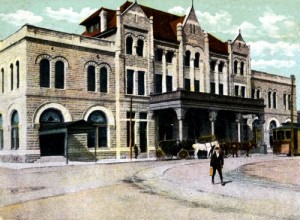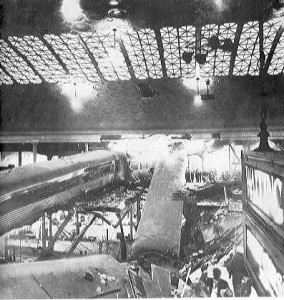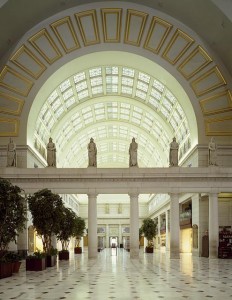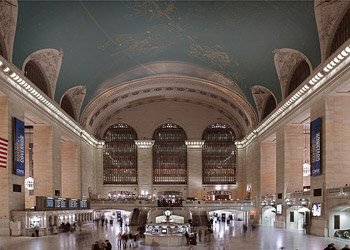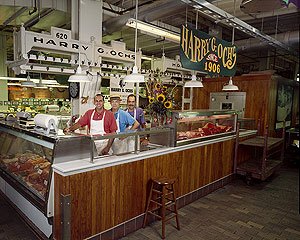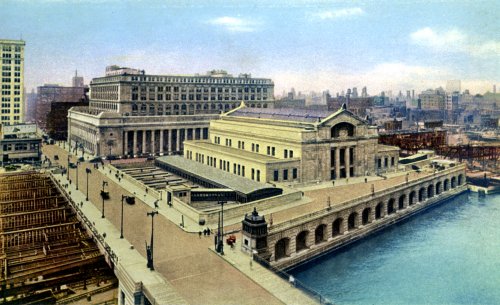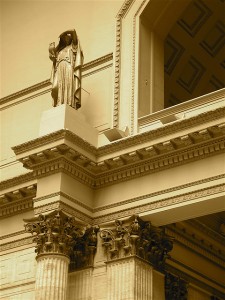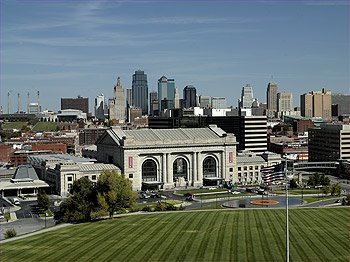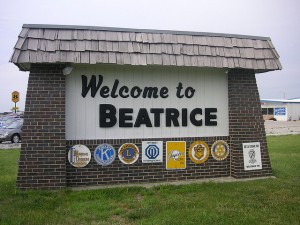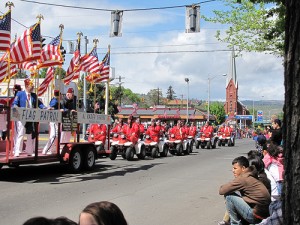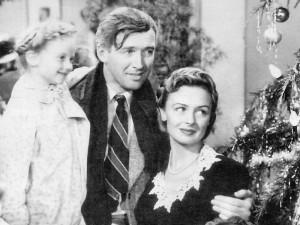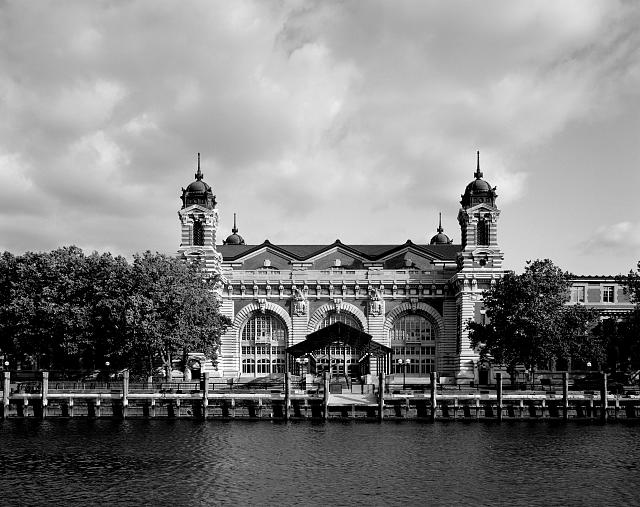I envy the poets and lyricists who write good-byes succinctly and memorably. Parting is Such Sweet Sorrow. Happy Trails to You. Thanks for the Memories, and the like.
Four years and 268 postings ago, I dove into the blogosphere by introducing myself and my Americana running buddy, my wife Carol M. Highsmith, whose photos have richly decorated this space. In fact, I’ve picked some of my favorites of hers to accompany these good-bye words.

This may be my favorite Hghsmith image of all, because it captures not only a nostalgic glimpse at gentler times gone by but also reflects our increasingly race-blind society in the 21st Century. (Carol M. Highsmith)
I am retiring — not to be confused with shy and retiring — on Nov. 8, after 26½ years of federal service. Twenty-six and one-half! At my age, one acts more and more like a 4-year-old, counting every quarter of every calendar year.
What a journey it has been at Carol’s side, dipping into every U.S. state and every big city, most middlin’-sized places, and what seems like a thousand family farms and vast parks and small towns.
This all started with my unrequited love of geography as a child. I was raised a curious “only child” on the fringes of Cleveland, Ohio, by a mother who did not drive. Except for one train trip to California, the farthest I got until high school was the east side of town.
As I hope you agree if you’ve followed this space for a while, I’ve made up for what I missed.
The taste of blogging has been a sweet one, and I intend to continue in the professional afterlife. I expect to be on the road eight months a year, driving, gripping (in the Hollywood sense, lugging cases and camera equipment) and blogging about America from the road as Carol caps off her career photographing early-21st-Century America. As I have told you from time to time, this is her gift to future generations as she continues to donate her life’s work, copyright-free, to the Library of Congress — the world’s greatest collection of human thought and creativity.

There’s no place in America that we like more than New Orleans, and not just at Mardi Gras. It’s a place that knows how to relax and have fun. Carol and I do the latter, but not always the former, pretty well. (Carol M. Highsmith)
We will be traveling under the auspices of the new, nonprofit This is America! Foundation, which is also sending videographer Connie Doebele across America for the same purpose. Beginning with the pack-up of our SUV in a week or so, I’ll be blogging on the This is America! site.
Here at the Voice of America, many others and I strongly believe that a sacred part of our mission is to tell the world the truth about our nation and our people. The commendable, the troubling, even the unflattering. That’s why I’ve taken pains to describe some rough-hewn, hard-luck places on our byways and back roads that Carol calls “Disappearing America,” as well as our glory destinations. And why I’ve invited discussions about some sensitive issues — our country’s hurried and harried children, most recently.
We are a sprawling land, diverse geographically and ethnically. A complicated place, young as civilizations go. So I’ve mixed in a lot of history in order to put the American experience into context.
I hope you’ll remember folks like Ann and John Boutwell, who saved an Alabama cotton gin factory in the nick of time; Robert Henry, who preserved an old plank road in Upstate New York; and Earl Shelton, an original “Okie” who fled Dust Bowl Oklahoma for the “streets paved with gold” in California during the Great Depression. And a hundred other Americans whom I’ve brought to your attention.

Carol is not one of those fancy-schmancy photographers. She’s a mighty good one, but her mission has been to document, not pretty up, our times. This is the Alabama cotton-gin factory that was saved. (Carol M. Highsmith)
Perhaps they and Carol and I have whetted your interest in experiencing our Land of the Free for yourself.

Don’t think for a moment, though, that Carol can’t make beautiful music, in a photographic sense, with images. This was taken with her infrared camera. (Carol M. Highsmith)
Blogging has been enjoyable and bemusing. It’s a rewarding blend of traditional objective, and more personal subjective, observation. My goal, borrowed from storytellers who have inspired me, has been to be interesting above all else. Not ranting or bloviating. Interesting.
I threw in “bloviating” as a tease for my final set of “Wild Words.” I hope they have helped you navigate through my flights of rhetorical fancy.

This view of “Amish Country” is also a quiet side of America that we both love. Whenever possible, we take small roads to get where we’re going, if only because we can easily pull off the road when we see something remarkable. (Carol M. Highsmith)
I’ve treasured the interplay with many of you. And with my two longstanding “second pairs of eyes” — my editors and friends Rob Sivak and Faith Lapidus.
Rob now runs VOA’s science desk, and his deep understanding of science, agriculture, and some alleys of technical esoterica has saved my bacon on more than one occasion. “Saved my bacon” — another Wild Expression to be explained below.
Faith is expert at whipping my occasional syntactical stumbles into clear and digestible form. She’s pounces on phrases that work ever so much better when they’re moved to more comfortable locations. Agreeably and supportively, Faith and Rob have made many a passable line tasty — just one of the reasons I will miss them terribly.

This sign has loomed over Scranton, New York, for a century. So many local icons like it have gone the way of the dodo. Only images such as Carol’s preserve them in our minds and hearts. (Carol M. Highsmith)
I mentioned that blogging can be bemusing. I still haven’t got used to the steady stream of nonsensical, off-topic comments, sent in supposed response to my meanderings. As I’ve pointed out once or twice, most of these are mass-produced in hopes that some gullible blogger will publish them. Somehow this lends the sender credibility, often for some commercial purpose.
So I won’t miss comments as . . .
Hello! in my opinion I’m sure poker is the most entertaining activity of all the card games.
. . . when I hadn’t even written about poker!
Those annoyances aside, I have treasured Carol’s and my treks on the old National Highway that runs from the Maryland mountains to the flatlands of Ohio; along sections of the Appalachian Trail footpath; in places called the “Little Apple” and “Surf City” and the “Flickertail State”; here and there and everywhere in America’s wealthiest state (Connecticut) and poorest (Mississippi); and to such magical locales as the real town that inspired snowy “Bedford Falls” in the classic Christmas movie, “It’s a Wonderful Life.

We’ll be heading to this place — San Francisco, which Carol caught beautifully at dusk — as one of our first stops in our “new life” on the road. (Carol M. Highsmith)
Half a century ago, there was a black-and-white TV show that concluded with a narrator’s declaration: “There are 8 million stories in the Naked City. This has been one of them.”
Truth be told, there are 311,591,917 stories in the United States of America at the latest reckoning. These blog postings have told 269 of them.
I hope to find many more out on the American road with Carol and 311,591,915 of our closest friends.

Washington will still be our home, and this seems like a fitting way to end this last VOA blog entry. The fireworks represent our excitement about a new life’s chapter. (Carol M. Highsmith)

































